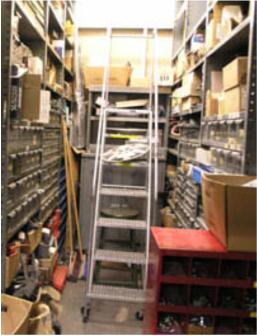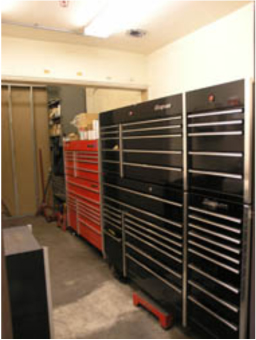

 Building 76 storage area before "5S" treatment...
Building 76 storage area before "5S" treatment...
Imagine your ideal process: If you were managing work orders, how would you delight the customer? What would the process look like and how would you improve it? These were some of the questions asked by the Facilities Division as it kicked off its first wave of “Kaizen” teams a few weeks ago. A Japanese word meaning “continuous improvement,” Kaizen is part of the “Lean” methodology for achieving higher standards on a regular basis. Continuous process improvement is part of Division Director Jennifer Ridgeway’s goal to support world class science at the Lab.
“From crafting their value stream plan, to drilling down and analyzing their customer or supplier base, the Kaizen teams set out to revitalize the culture of how business is done,” said Operational Excellence Manager Cesar Sanchez, with the Facilities Division.
Operations groups — including Environment, Health and Safety (EH&S), Procurement, IT, and Human Resources — partnered with Facilities, bringing together managers, line employees, and customers to improve processes around performance metrics, work orders, procurement, total productive maintenance (TPM), and “5S” (sort, shine, set, standardize and sustain). TPM and 5S are Lean concepts to increase productivity and reduce waste.
 ...and after.
...and after.
Richard DeBusk, EH&S Safety Group Manager, enjoyed the collaborative efforts. “We all came together and identified bottlenecks and current and future states. It worked very well. We were able to gain a broader viewpoint by having a diverse group of cross-functional staff.”
Chief Operating Officer Jim Krupnick, DOE Berkeley Site Office staff, and senior management reviewed the work plans presented by the Kaizen teams. The proposed savings ranged from 19.6 miles of walking for each Plant Maintenance Technician (PMT) per year, reduced lead times from 123 days to 1 day, to 99 percent uptime of critical systems.
One of the proposed savings, reducing the number of miles walked by PMTs, meant reducing the creators of waste, i.e. unnecessary transport, excess motion, wait time, and excess inventory. For example, the travel distance to repair one small pump or motor (to and from the office, truck, work bench, and tool box), is less than 0.08 mile per day, or 22 miles a year per PMT. Reducing waste meant reducing their travel distance to 0.01 mile a day, resulting in a significant improvement in productivity.
“Out of all of my experiences working here, one of my fondest memories is working with a team,” said Krupnick. “This is a great start and I’m looking forward to seeing the results of this initiative.”
These efforts contribute to Lab Director Paul Alivisatos’ Strategic Initiative for a Safe and Efficient Berkeley Lab. “This approach of analyzing processes is broadly applicable and can benefit other areas of the Lab,” said Chris Peach, Group Lead in the IT Division. “I’m currently developing a survey in IT to develop metrics in my department around customer service, quality, and resources.”
“This initiative is a process, not a project,” said Ridgeway. “Change is constant, and it’s not a one-time event. Continuous process improvement is essential and is really a lifestyle change. To me, this whole process is about moving forward and continuing to get better.”
Carpenter Gerald Martin has found the Lean concepts useful, not only for work, but also at home. “Our Kaizen team revamped the Facilities Maintenance Shop, but it doesn’t end there. I’ll be using this approach to reorganize my personal shop at home. I’ve been trying to improve my shop for 10 years, and now I have an incentive to really do it.”
Today at Berkeley Lab is produced by Public Affairs' Communications Department